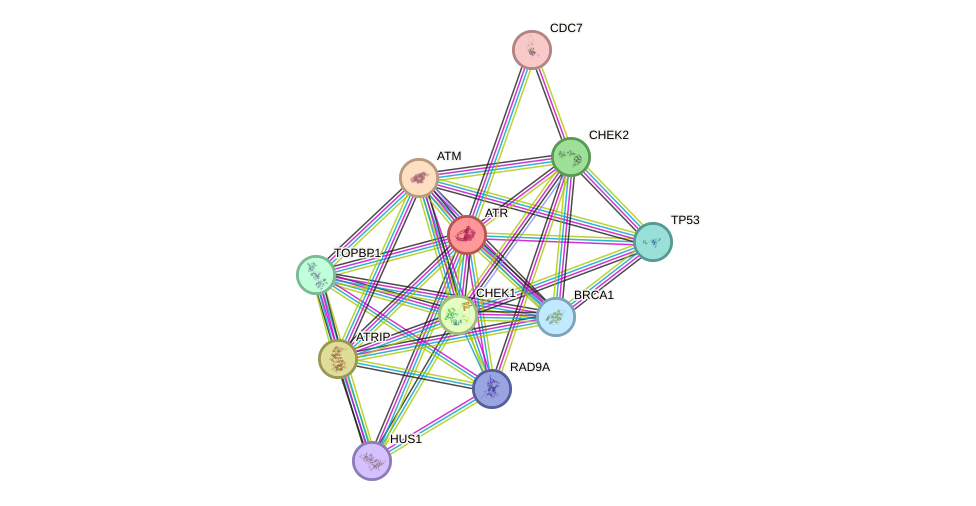GenAge entry for ATR (Homo sapiens)
Entry selected based on evidence directly linking the gene product to ageing in a mammalian model organism
Gene name (HAGRID: 231)
- HGNC symbol
- ATR
- Aliases
- FRP1; SCKL; SCKL1; MEC1
- Common name
- ATR serine/threonine kinase
Potential relevance to the human ageing process
- Main reason for selection
- Entry selected based on evidence directly linking the gene product to ageing in a mammalian model organism
- Description
ATR is involved in DNA repair by activating checkpoint signalling during genotoxic stresses including the phosphorylation of ageing-related proteins such as BRCA1 and TP53. Together with ATM, ATR has been suggested to regulate TP53 and WRN [1681].
ATR disruption in mice results in embryonic lethality in homozygous animals while heterozygous mice develop normally but have increased tumour incidence [1679]. Deletion of ATR in young adult mice eliminates 80-90% of proliferating cells and results in several age-related phenotypes accompanied by a depletion of stem and progenitor cells and exhaustion of tissue renewal and homeostatic capacity [1864]. Patients with mutations affecting ATR develop Seckel syndrome, characterized by growth retardation, dwarfism, and mental retardation, clinical features often found in disorders involving impaired DNA-damage responses [1680]. A possible role in human ageing is plausible though further research is necessary to confirm this hypothesis.
Cytogenetic information
- Cytogenetic band
- 3q23
- Location
- 142,449,235 bp to 142,578,826 bp
- Orientation
- Minus strand
Protein information
- Gene Ontology
-
Process: GO:0000077; DNA damage checkpoint
GO:0006260; DNA replication
GO:0006281; DNA repair
GO:0006974; cellular response to DNA damage stimulus
GO:0007049; cell cycle
GO:0007275; multicellular organism development
GO:0008156; negative regulation of DNA replication
GO:0018105; peptidyl-serine phosphorylation
GO:0032212; positive regulation of telomere maintenance via telomerase
GO:0034644; cellular response to UV
GO:0036297; interstrand cross-link repair
GO:0042493; response to drug
GO:0043517; positive regulation of DNA damage response, signal transduction by p53 class mediator
GO:0046777; protein autophosphorylation
GO:0070198; protein localization to chromosome, telomeric region
GO:0071480; cellular response to gamma radiation
GO:0090399; replicative senescence
GO:0097694; establishment of RNA localization to telomere
GO:0097695; establishment of macromolecular complex localization to telomere
GO:1900034; regulation of cellular response to heat
GO:1901796; regulation of signal transduction by p53 class mediator
GO:1904884; positive regulation of telomerase catalytic core complex assembly
Cellular component: GO:0000784; nuclear chromosome, telomeric region
GO:0005654; nucleoplasm
GO:0005694; chromosome
GO:0005794; Golgi apparatus
GO:0016605; PML body
Hide GO termsFunction: GO:0003677; DNA binding
GO:0004672; protein kinase activity
GO:0004674; protein serine/threonine kinase activity
GO:0005515; protein binding
GO:0005524; ATP binding
GO:0032405; MutLalpha complex binding
GO:0032407; MutSalpha complex binding
Protein interactions and network
- Protein-protein interacting partners in GenAge
- TP53, TERT, ATM, WRN, E2F1, EGFR, NBN, BRCA1, RPA1, BLM, HSP90AA1, ABL1, BRCA2, EP300, XRCC5, POLD1, XPA, HDAC1, CREB1, HDAC2, H2AFX, CDKN2A, ATR, CHEK2, PIK3CA
- STRING interaction network
Retrieve sequences for ATR
Homologs in model organisms
- Danio rerio
- atr
- Drosophila melanogaster
- mei-41
- Mus musculus
- Atr
- Rattus norvegicus
- Atr
- Saccharomyces cerevisiae
- MEC1
- Schizosaccharomyces pombe
- rad3
In other databases
- GenAge model organism genes
- A homolog of this gene for Saccharomyces cerevisiae is present as MEC1
- LongevityMap
- This gene is present as ATR
- CellAge
- This gene is present as ATR

